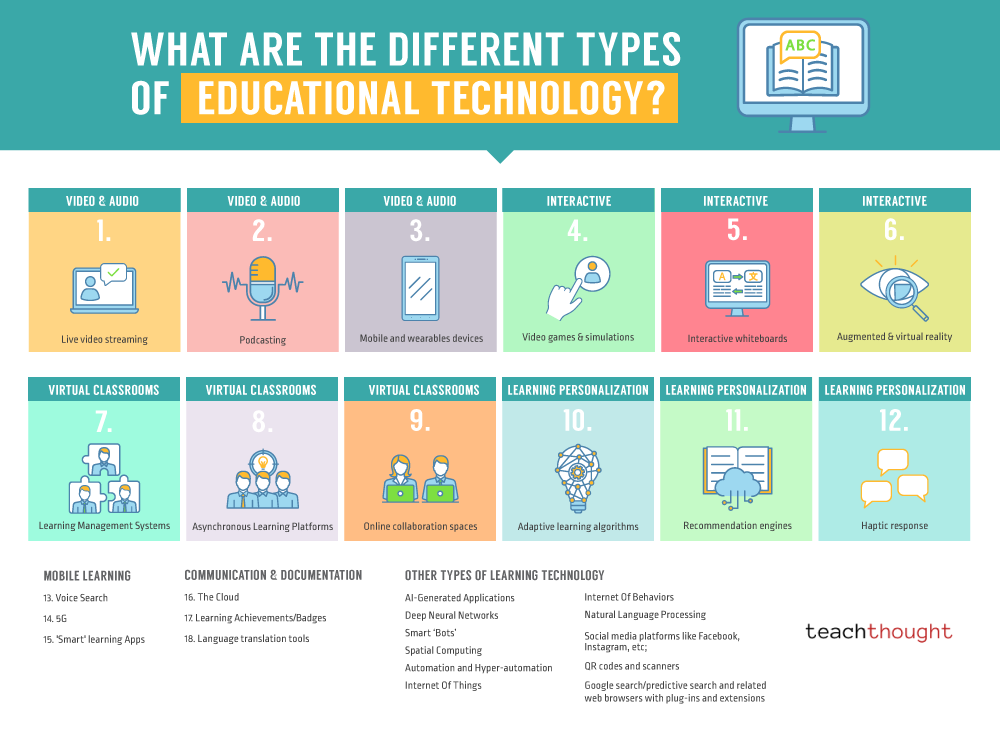

by Terry Heick
This is a sponsored article. You can find out more about our content policy sponsored here.
This is a sponsored article. You can find out more about our sponsored content policy here.
The objective of this post is simple: providing examples of learning technology – identification and clarifying what learning technology “is” and “resembles” and out of class.
In fact, I started this post in 2015 and I thought it could be useful for some, so I updated it and finished. Some questions frequently asked for the context.
What is the simple definition of technology?
We tend to consider “technology” as a new one – and generally computer hardware or software. This is only a type of technology.
More broadly, a simple definition of technology is the application of “things” (often knowledge) that cause change. This “change” can take the form of the development of science, problem solving, the production of commercial goods, the improvement of health care, the sharing of information, the modification of physical landscapes, the creation of physical and digital structures, etc.
Definitions vary from dictionary to the philosophical to the conceptual and so on. For our needs, we will define “technology” as the application of tools, knowledge, processes or other methods of achieving objectives.
See also 4 examples of technology in the special education class
Regarding its news, “technology” is also a relative term. At one point, a pencil was considered a “new” technology. In socio -cultural contexts, it is also relative as a technology that could be almost invisible in a company could change completely (for better or for worse) another company. The meaning is contextual, just like technology as a concept.
What is educational technology for teaching and learning?
Education technology is the application of new tools and ideas that help teachers teach and learn students.
What are the functions of education technology?
Education technology can automate process, improve access to information, enable Knowledge and data sharing, double Information between media forms, vicar important knowledge, communicate ideas, visualize Critical concepts, and more.
(To be fair, technology can also destroy, poison, erase, mislead, etc., but it is more a criticism of applied technology rather than the concept of technology itself.)
To understand technology as a concept, it might be useful to consider certain related words: technical, technical, technician, technology, technically, technocracy and technophile
The root of technology is Greek: Tekhne (art, crafts) and –lodge.
Learning technologies in class are the tools, systems and techniques that facilitate, activate and promote learning.
This can happen in the form of a learning management system or a platform such as the Khan Academy which helps students practice new skills, a community “encyclopedia” like Wikipedia which allows people to manage and share knowledge, interactive white tables that allow students to learn by guided practice with the teacher. Learning technology can be simple (such as a calculator) or advanced (such as virtual reality).
What are class learning technologies?
Other less “visible” examples of technology in education
Of course, all “technology” is not hardware or software. If technology is the application of tools, systems and knowledge in order to achieve a goal, examples of learning technology really open.
Program mapping: collection, organization and intentional distribution of knowledge
Evaluation: the attempt to measure the understanding or control of a student of content or skills. In this sense, the function of technology is to do something concrete abstract (understanding) (a letter or a number). In this case, the effect of educational technology is quantification and qualification.
The concept of public education: the intention to educate all citizens through the transformation of dollars of text into buildings (schools) and systems (districts, classes, hours, etc.) which help children learn
A Socratic Seminar: a learning system by a guided survey and a discussion
Other examples: Parent-Share-School Conferences, School Hours, Bulletins, Organization of classrooms by age, categorization of knowledge and skills in “content areas”, and even school electricity and plumbing.



